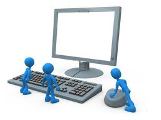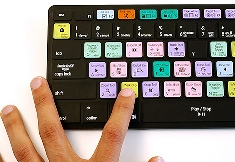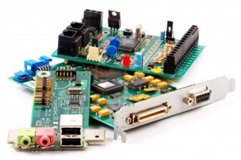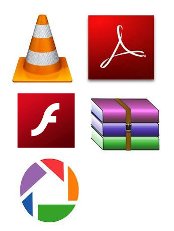

LAN
Stands for "Local Area Network," and is pronounced like "land" without the "d". (Computer people will think you're weird if you pronouce it "L-A-N"). A LAN is a computer network limited to a small area such as an office building, university, or even a residential home. Most mid to large-sized businesses today use LANs, which makes it easy for employees to share information. Currently, the most common type of LANs are Ethernet-based and use software from Novell or Oracle. However, with the emergence of wireless networking, wireless LANs have become a popular alternative.
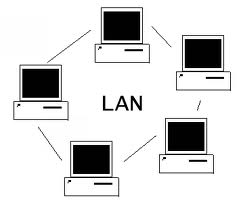
Laptop
Laptop computers, also known as notebooks, are portable computers that you can take with you and use in different environments. They include a screen, keyboard, and a trackpad or trackball, which serves as the mouse. Because laptops are meant to be used on the go, they have a battery which allows them to operate without being plugged into a power outlet. Laptops also include a power adapter that allows them to use power from an outlet and recharges the battery.

While portable computers used to be significantly slower and less capable than desktop computers, advances in manufacturing technology have enabled laptops to perform nearly as well as their desktop counterparts. In fact, high-end laptops often perform better than low or even mid-range desktop systems. Most laptops also include several I/O ports, such as USB ports, that allow standard keyboards and mice to be used with the laptop. Modern laptops often include a wireless networking adapter as well, allowing users to access the Internet without requiring any wires.
While laptops can be powerful and convenient, the convenience often comes at a price. Most laptops cost several hundred dollars more than a similarly equipped desktop model with a monitor, keyboard, and mouse. Furthermore, working long hours on a laptop with a small screen and keyboard may be more fatiguing than working on a desktop system. Therefore, if portability is not a requirement for your computer, you may find better value in a desktop model.
Laser Printer
A laser printer is a printer that uses a focused beam or light to transfer text and images onto paper. Though contrary to popular belief, the laser does not actually burn the images onto the paper. Instead, as paper passes through the printer, the laser beam fires at the surface of a cylindrical drum called a photoreceptor. This drum has an electrical charge (typically positive), that is reversed in areas where the laser beam hits it. By reversing the charge in certain areas of the drum, the laser beam can print patterns (such as text and pictures) onto the photoreceptor.
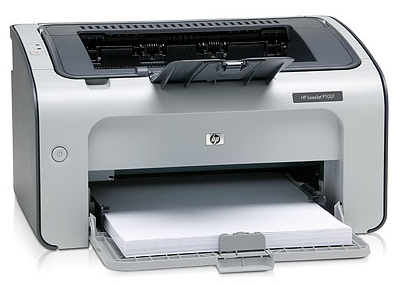
Once the pattern has been created on the drum, it is coated with toner from a toner cartridge. The toner is black in most cartridges, but may be cyan, magenta, and yellow in color laser printers. The positively charged toner clings to areas of the drum that have been negatively charged by the laser. When the paper passes through the printer, the drum is given a strong negative charge, which allows the toner to transfer and stick to the paper. The result is a clean copy of the image written on the paper.
Because laser printers do not use ink, they have less image smearing problems than inkjet printers and are able to print pages faster. While laser printers and toner cartridges typically cost more than inkjet printers and ink cartridges, most laser toner cartridges last several times longer than ink cartridges, which makes their cost per page about equal. For this reason, businesses tend to use laser printers, while consumers are more likely to use inkjet printers. Laser printers typically have a resolution of 600 dpi (dots per inch) or higher.
Latency
This is the amount of time it takes a packet of data to move across a network connection. When a packet is being sent, there is "latent" time, when the computer that sent the packet waits for confirmation that the packet has been received. Latency and bandwidth are the two factors that determine your network connection speed.
LCD
Stands for "Liquid Crystal Display." LCDs are super-thin displays that are used in laptop computer screens and flat panel monitors. Smaller LCDs are used in handheld TVs, PDAs, and portable video game devices. The image on an LCD screen is created by sandwiching an electrically reactive substance between two electrodes. This color of this substance can be changed by increasing or reducing the electrical current. Since LCD screens are based on the principle of blocking light (rather than emitting it), they use up much less power than standard CRT (Cathode-Ray Tube) monitors.

LED
LED is short for "Light-Emitting Diode." It is a type of electronic light source that is activated by an electrical current. LEDs are highly energy-efficient and last much longer than traditional light bulbs. They can used for indicator lights, clock displays, street lights, and many other applications. LEDs have also begun to replace traditional bulbs as the backlight source in LCD monitors and TVs.
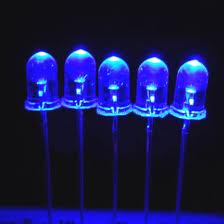
LIFO
Stands for "Last In, First Out." LIFO is a method of processing data in which the last items entered are the first to be removed. This is the opposite of LIFO is FIFO (First In, First Out), in which items are removed in the order they have been entered.
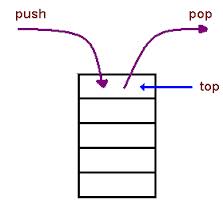
To better understand LIFO, imagine stacking a deck of cards by placing one card on top of the other, starting from the bottom. Once the deck has been fully stacked, you begin to remove the cards, starting from the top. This process is an example of the LIFO method, because the last cards to be placed on the deck are the first ones to be removed.
The LIFO method is sometimes used by computers when extracting data from an array or data buffer. When a program needs to access the most recent information entered, it will use the LIFO method. When information needs to be retrieved in the order it was entered, the FIFO method is used.
Link
When you are browsing the Web and you see a highlighted and underlined word or phrase on a page, there is a good chance you are looking at a link. By clicking on a link, you can "jump" to a new Web page or a completely different Web site. While text links are typically blue and underlined, they can be any color and don't have to be underlined. Images can also serve as links to other Web pages. When you move the cursor over a link in a Web page, the arrow will turn into a little hand, letting you know that it is a link. The term "hypertext" comes from the way links can quickly send you to another Web destination.
LinkedIn is a business-oriented social networking website. It allows you to create a custom profile and add other LinkedIn users to your list of connections. Unlike Facebook, LinkedIn profiles are designed to be professional, rather than personal. They appear like a resume, with education and work experience being the most prominent. By using LinkedIn, you can keep in touch with past colleagues and meet new potential business partners.

Linux
Linux is a free, open source, Unix-like operating system. It is available in several different distributions, including CentOS, Debian, Ubuntu, and Red Hat. Linux can run on several different hardware platforms and may even be used as the OS for electronics devices besides computers. Though Linux is not commonly installed on home computers, it is widely used by Web hosting companies and has many other specialized applications.
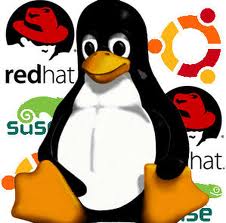
Localhost
"Localhost" refers to the local computer that a program is running on. For example, if you are running a Web browser on your computer, your computer is considered to be the "localhost." While this does not need to be specified when using a single computer, the localhost does need to be defined when running programs from multiple computers. For example, a network administrator might use his local machine to start a Web server on one system and use a remote access program on another. These programs would run from computers other than the localhost.
In the example above, the two non-local computers must be defined by their IP addresses. The local machine is defined as "localhost," which gives it an IP address of 127.0.0.1. This is considered a "loopback" address because the information sent to it is routed back to the local machine. Localhost is often used in Web scripting languages like PHP and ASP when defining what server the code should run from or where a database is located.
Log File
A log file contains a record of events generated by a software program or output by a hardware device. Most log files are saved in a plain text format, which allows them to viewed in a basic text editor. Log files may be generated by Web servers, software installers, or a variety of applications. The data stored in a log file can be used to troubleshoot software issues or run reports.
Most log files have a .LOG file extension.
Example: "The list of installed files is saved in a log file."
Logic Gate
Logic gates perform basic logical functions and are the are the fundamental building blocks of digital integrated circuits. Most logic gates take an input of two binary values, and output a single value of a 1 or 0. Some circuits may have only a few logic gates, while others, such as microprocessors, may have millions of them. There are seven different types of logic gates, which are outlined below.
In the following examples, each logic gate except the NOT gate has two inputs, A and B, which can either be 1 (True) or 0 (False). The resulting output is a single value of 1 if the result is true, or 0 if the result is false.
AND - True if A and B are both True
OR - True if either A or B are True
NOT - Inverts value: True if input is False; False if input is True
XOR - True if either A or B are True, but False if both are True
NAND - AND followed by NOT: False only if A and B are both True
NOR - OR followed by NOT: True only if A and B are both False
XNOR - XOR followed by NOT: True if A and B are both True or both False
By combining thousands or millions of logic gates, it is possible to perform highly complex operations. The maximum number of logic gates on an integrated circuit is determined by the size of the chip divided by the size of the logic gates. Since transistors make up most of the logic gates in computer processors, smaller transistors mean more complex and faster processors.
Login
If you are ever asked to enter your username and password, you are being asked to enter your login information. A login is a combination of information that authenticates your identity. This could be a name and password or an ID number and security code. Many secure Web sites use login information to authenticate visitors before allowing them access to certain areas of the site. Unlike the words "brush" and "comb," this term should not be used as both a noun and a verb. It should only be used as a noun, (you don't login to a server, you log in to it).


| Terms |
| LAN |
| Laptop |
| Laser Printer |
| Latency |
| LCD |
| LED |
| LIFO |
| Link |
| Linkedln |
| Linux |
| Localhost |
| Log File |
| Logic Gate |
| Login |
| Web Pages by Students |
ABC of C Language by Shailender Sharma |
Bootable Pen Drive by Avtar Singh |
e-Trash or e-Treasure? by Pallavi Bagga |
Lakshya by Rabina Bagga |
OOPs Concepts by Navjot Kaur |
Fitness First by Ankush Rathore |
Information Systems by Kajal Gupta |
Quiz Contest in C++ by Rajnish Kumar |
Core Java (Tutorial) by Shyena |
C Language Q&A by Anmol Sharma |
HTML 5 Tutorial by Kishan Verma |




